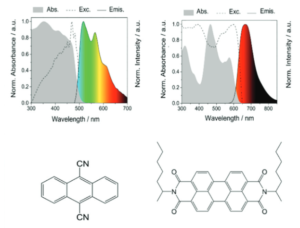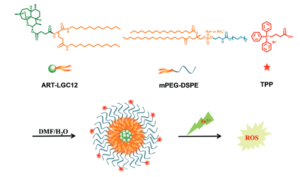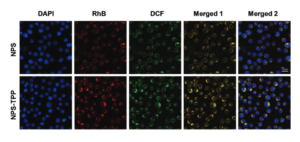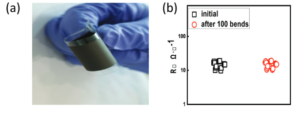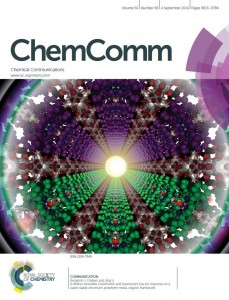We’re all used to communications and computing happening at high, and seemingly ever-increasing speeds. Continuing on this trajectory requires the development of materials capable of acting as micro/nanoscale waveguides that don’t experience interference effects from strong external electromagnetic fields. Molecular crystals represent an exciting but relatively under-explored materials class due to their inherently limited emission and absorption properties. However, an international group of researchers recently combined two different crystalline materials with complementary optical properties in a filled-hollow crystal architecture, involving no binding materials or polymer matrices.
The group used 9,10-dicyanoanthracine (DCA) as the hollow outer crystal, with a perylene diimide derivative (PDI) as the interior compound (Figure 1). When combined, these two compounds exhibit fluorescence that covers the visible and near-IR portions of the electromagnetic spectrum. The researchers grew hollow crystals of DCA with diameters ranging from 50-400 μm in diameter with pores of 10-200 μm and filled them with 1-50 μm PDI crystal fibrils manually by hand(!) (Figure 2) (I honestly can’t imagine how many crystals ended up broken during that experimental learning curve!). The assembled structure for study had a single hollow DCA crystal filled with 18 individual PDI fibrils to create the waveguide.
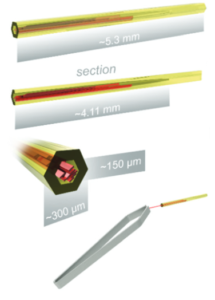
Figure 2. Schematic of hollow crystal architecture (top) with demonstration of construction (bottom).
When the researchers excited the full structure with a 365 nm continuous wavelength LED, both crystal components emitted light that was guided down to the opposite end. The specific makeup of the spectrum depends on the point of illumination; only the excited compounds emit. This supports the active waveguiding capabilities of the materials. The emissive properties can also be controlled by changing the excitation wavelengths to exclude the absorbance of one of the molecular crystals. PDI can be selectively excited using light above 550 nm and both PDI and DCA act simply as passive waveguides for light in the infrared region of the spectrum, of particular importance for wireless communication. This study represents an exciting next step for organic molecular materials as optical waveguides with a new architecture for devices.
To find out more please read:
A filled organic crystal as a hybrid large-bandwidth optical waveguide
Luca Catalano, Patrick Commins, Stefan Schramm, Durga Prasad Karothu, Rachid Rezgui, Kawther Hadef and Panče Naumov
Chem. Commun, 2019, 55, 4921-4924.
About the blogger:
 Beth Mundy is a PhD candidate in chemistry in the Cossairt lab at the University of Washington in Seattle, Washington. Her research focuses on developing new and better ways to synthesize nanomaterials for energy applications. She is often spotted knitting in seminars or with her nose in a good book. You can find her on Twitter at @BethMundySci.
Beth Mundy is a PhD candidate in chemistry in the Cossairt lab at the University of Washington in Seattle, Washington. Her research focuses on developing new and better ways to synthesize nanomaterials for energy applications. She is often spotted knitting in seminars or with her nose in a good book. You can find her on Twitter at @BethMundySci.


